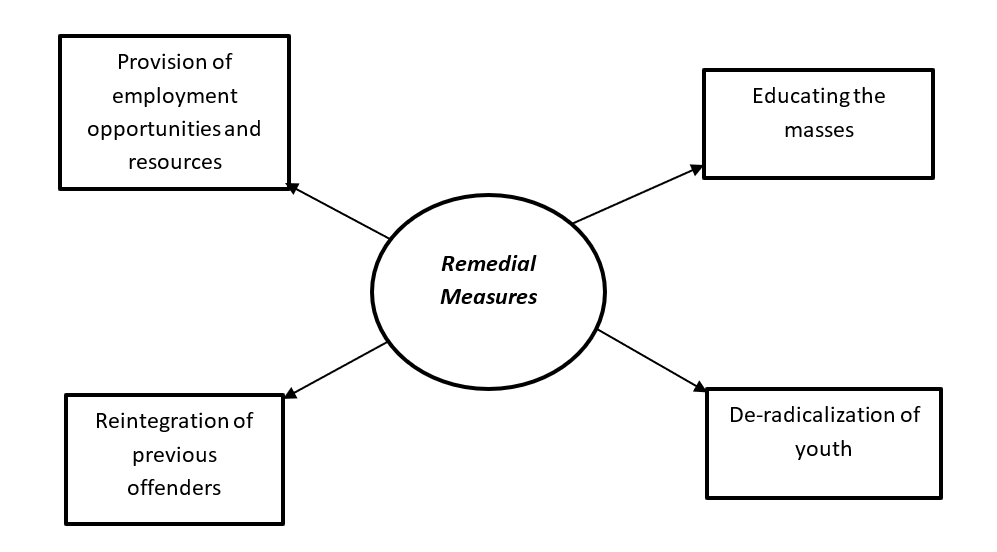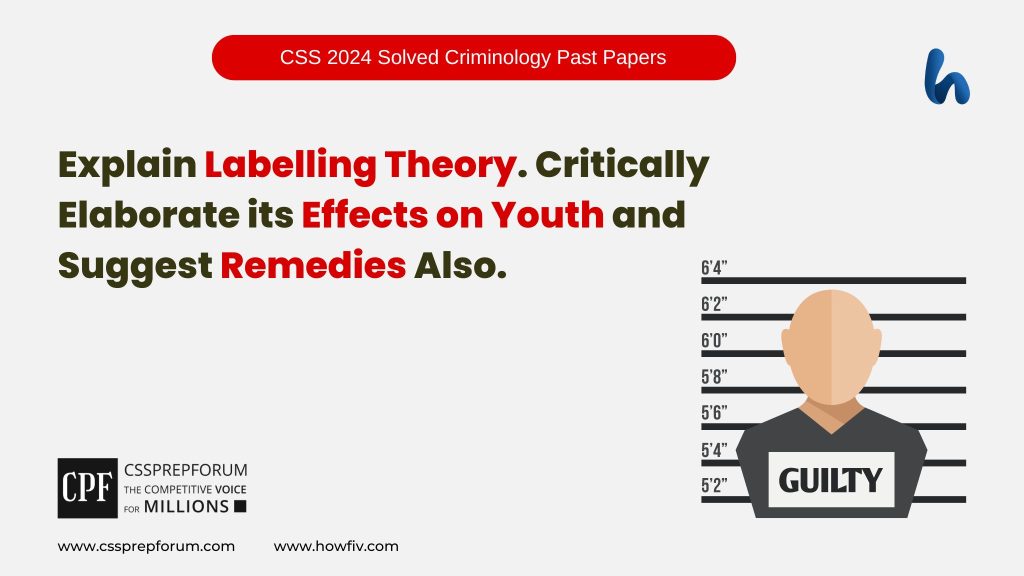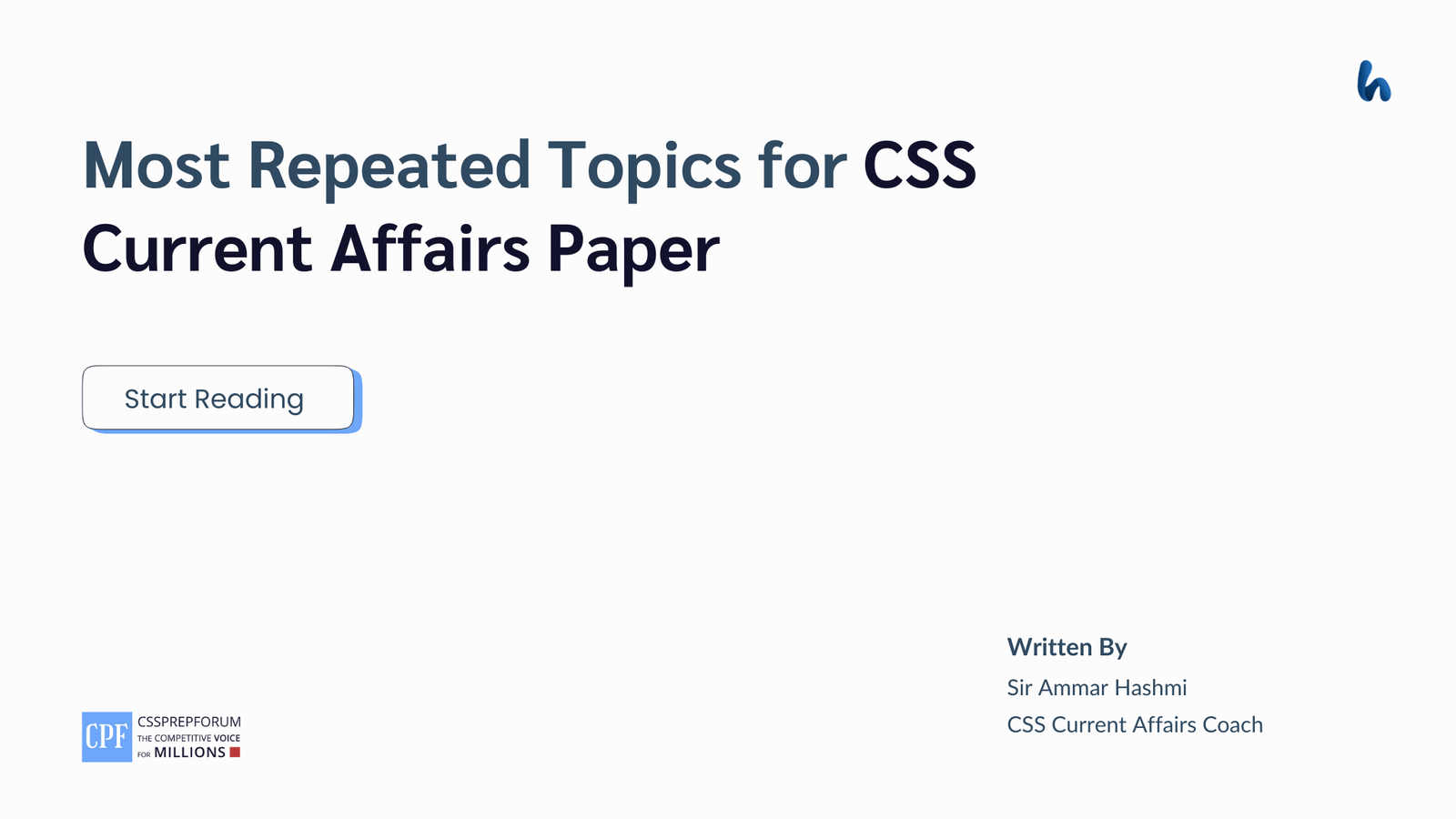CSS Solved Criminology Past Paper 2024 | Labelling Theory and its Details

Question Breakdown
In this question, three main parts will be discussed: the labelling theory, its effects on youth, and the remedial measures to mitigate its impacts. The examiner has demanded a detailed explanation of the labelling theory and its impacts on the youth. To ace the criminology exams, a proper explanation of the concepts is required by using the theories of various proponents and criminologists. For bonus marks, one can add definitions and relevant quotations. Proponents and assumptions of the theory should be discussed to explain the labelling theory. Moreover, the impact of the theory on youth can be explained through examples of various societies. These examples and theories will help in enhancing the quality of your answer.
Outline
1-Introduction
2-Labelling theory
- ✓Proponents
- ✓Explanation of the Theory
3-Effects of Labelling on Youth in Pakistan
- ✓Stigmatization
- ✓Criminal Behavior
- ✓Recidivism
- ✓Social Exclusion
4-Remedial Measures to Mitigate the Impact of Labelling on Youth in Pakistan
- ✓Educating the Masses
- ✓Reintegration of Deviant Individuals or Criminals after their De-radicalization
- ✓Providing Employment Opportunities and Giving Access to Resources
5-Critical Analysis
6-Conclusion

Answer to the Question
Introduction
The labelling theory of criminology originates from the sociological viewpoint of ‘Symbolic Interactionism’. It puts forth the ways through which society categorizes and deals with those who do not conform to the established social norms. According to labelling theory, labels can either benefit or harm people’s behaviour and sense of self. The theory delineates that those in positions of power are more prone to categorize the weak as deviant, and those who are stigmatized may either adopt or reject these labels. The labels that society gives to a particular individual often shape one’s behaviours. They can also adversely affect the youth due to discrimination in different socio-political and economic arenas of life.
Labelling Theory
Proponents
In 1963, the theory was first introduced by Howard Becker in his book “Outsiders”, in which he accentuated the interactions among people as one of the causes of deviance. Labelling theory is based on the Symbolic Interactionism Perspective of Sociology in which sociologists like George Herbert Mead and Charles Horton Cooley delineate that every phenomenon of society, including crime and deviance, is due to the interaction between individuals. Edwin Lemert delineated primary deviance and secondary deviance in “Social Pathology”. To elaborate, primary deviance is an initial attempt to violate social norms or criminal law, which may or may not be labelled subsequently. Secondary deviance, on the other hand, is a criminal offence due to the label imposed.

Besides, Howard S. Becker, in his book “Becoming a Marijuana User”, puts forth the role of society and its reactions in promoting substance abuse. Furthermore, Erving Goffman studied the association of labelling and stigma with perpetual negative identities of individuals, thus leading to marginalization.
Explanation of the Theory
Society labels an individual based on his criminal act, lowering his self-image. As a reaction, the individual adopts the labelled behaviour. Even though some criminological initiatives aimed at mitigating crime—similar to rehabilitation programs—are intended to assist offenders, they may compel them to adopt a life of crime because of the stigma that society attaches to those who show such behavior. Hence, they start to accept the labels for themselves as their society begins to treat them according to their labels.
On the other hand, when someone acts in a way that others find unacceptable, they label them as deviant, which the person gradually internalizes and accepts. At the very core of the labelling theory lies the idea of social reaction, the response or reaction of others, to the individual’s behaviour or the individual himself.
Effects of Labelling on Youth in Pakistan
The reaction of society after a criminal act plays a crucial role in making an individual deviant. Deviance refers to the violation of social norms. Primary deviance occurs when the label is imposed on the attempt of crime whereas becoming a criminal due to the imposed label is known as secondary deviance. The labels imposed by society differ from time to time and in accordance with the cultures; however, they sway the people, as indicated by David Rosenhan in his research titled ‘On Being Sane in Insane Places’.

Stigmatization
According to the sociologists B. G. Link and J. C. Phelan, stigma is defined as a set of particular, negative opinions and prejudices associated with a label. These can be seen in and spread through the media or regular interpersonal encounters. When examining the consequences of labelling, theorists classify labels into two types: formal and informal. Formal labels are given to a person by someone authoritative or having a formal status in order to recognize abnormal behaviour. For instance, a person found guilty or placed under arrest for committing a crime is formally called a “criminal” because he is believed to have participated in an action considered abnormal (such as breaching the law).
Nonetheless, organizations not possessing formal power to label someone deviant can also apply labels to individuals. According to D. R. Kavish, C. W. Mullins and D. A. Soto, such labels are informal. For instance, teachers and other members of the school staff may designate a youngster as a “troublemaker” and handle him according to that label by making him face detention. For example, in Pakistan, if a juvenile is arrested for petty theft, he will be labelled as a criminal for life, which affects one’s image as well as opportunities.
Criminal Behavior
The Symbolic Interactionism Perspective of Sociology explains that the creation of a society is a result of regular and meaningful interactions between various individuals. Furthermore, Charles Cooley delineates in his Looking Glass Self theory that the way one perceives oneself depends on how others perceive him or her. The labelled person is often viewed as deceitful by others, thus instilling criminal behaviour or deviance. For example, in the 1990s, serial killer Javed Iqbal in Pakistan killed and raped more than a hundred children in Lahore. Among several other reasons, one major reason behind the instilling of his heinous crimes was the wide coverage by the media, presenting him as “monstrous”.
Recidivism
Recidivism means the commission of crime of a habitual criminal. According to the Black’s Law Dictionary, recidivism can be defined as
“The tendency of a convicted criminal to relapse into a habit of criminal activity”
One of the major causes of recidivism is the unemployment of convicts due to social labelling, leading to poverty. The convicts are deprived of employment opportunities after they are released from jail, which not only leads to their marginalization but also internalizes their criminal label.
Social Exclusion
The deviant people are rejected by society, leading to their social exclusion and criminal activities. According to Travis Hirschi, people with strong social bonds are less likely to indulge in criminal behaviours. On the other hand, as R. J. Sampson and J. H. Laub delineate, stigmatized individuals are adversely affected and find it troublesome to establish relations with the non-deviant people of society, resulting in weak social bonds and instilling criminal behaviour. Furthermore, labelling minimizes employment as well as education opportunities, leading to long-lasting criminal behaviours among individuals. For instance, women in Pakistan are marginalized, particularly those who assert independence. In the contemporary era, most of the terrorist organizations recruit women to carry out attacks. Henry Thomas Buckle once said,
“Society prepares crimes, and criminals commit it.”
Remedial Measures to Mitigate the Impact of Labelling on Youth in Pakistan
Labelling results in the repetition of crimes; therefore, it is crucial to educate the masses regarding the treatment of deviant or criminal individuals after their reformation. Through education, by reducing stigmatizing attitudes and providing opportunities to convicts, the detrimental effects of labelling can be minimized, thus promoting reintegration.

Educating the Masses
In order to mitigate the consequences of stigmatization and labelling, transforming social institutions like family and education and people’s mindsets from negative to positive is paramount. Teachers and parents should be trained in order to prevent them from labelling their children as troublemakers or deviants. Instead, they ought to be encouraged by highlighting their strengths and talents, inculcating a positive identity.
Reintegration of Deviant Individuals or Criminals after their De-radicalization
When the ideas and mindsets of criminals are de-radicalized, inclusive behaviours should be adopted by society’s individuals. Individuals should not be labelled on the basis of their past actions; rather, they should be reintegrated. Furthermore, the masses ought to be made aware of the detrimental impact of labelling and be empathetic towards each other.
Providing Employment Opportunities and Giving Access to Resources
According to the Human Needs Theory byJohn Burton, there are certain human essentials like identity, economic security, political participation, etc. If individuals are deprived of these essentials, they might indulge in criminal activities. Therefore, it is crucial to ensure that all young people, irrespective of their labels or histories, have equal access to resources and opportunities such as healthcare, work, education, etc. Invest in initiatives related to community development and career education to give young people a responsibility as well as give them opportunities for growth and success.
Critical Analysis
Labelling theory explains the reaction of society to the criminal or deviant behaviour of an individual. According to the Sociological School of Criminology, crime is learned by interaction with other individuals. If society stigmatizes an individual, then one learns and adopts that behaviour in the long term. Though negative labelling of individuals causes crimes and adversely impacts them, individuals can be labelled positively so that they adopt positive behaviours and self-confidence. Furthermore, labelling is not the only cause of crime. Rather, there might be certain biological and psychological causes of crime, as explained by Biological and Psychological Schools of Thought of Criminology.
Conclusion
In a nutshell, a labelling theory proposed by Howard Becker is about the creation of crime by labelling the behaviour of individuals. Most of the time, society reacts negatively to the primary deviance, thus creating habitual criminals by instilling the label of “criminals” amongst those individuals. Stigmatization not only results in increased criminal activities but also the alienation of such individuals due to social exclusion. Furthermore, they are also deprived of fundamental needs of identity, economic belongingness, etc. In order to mitigate the negative impacts of labelling, educating the masses is paramount.

CSS Solved Past Papers’ Essays
Looking for the last ten years of CSS and PMS Solved Essays and want to know how Sir Kazim’s students write and score the highest marks in the essays’ papers? Then, click on the CSS Solved Essays to start reading them.
CSS Solved Essays
CSS Solved General Science & Ability Past Papers
Want to read the last ten years’ General Science & Ability Solved Past Papers to learn how to attempt them and to score high? Let’s click on the link below to read them all freely. All past papers have been solved by Miss Iqra Ali & Dr Nishat Baloch, Pakistan’s top CSS GSA coach having the highest score of their students. General Science & Ability Solved Past Papers












